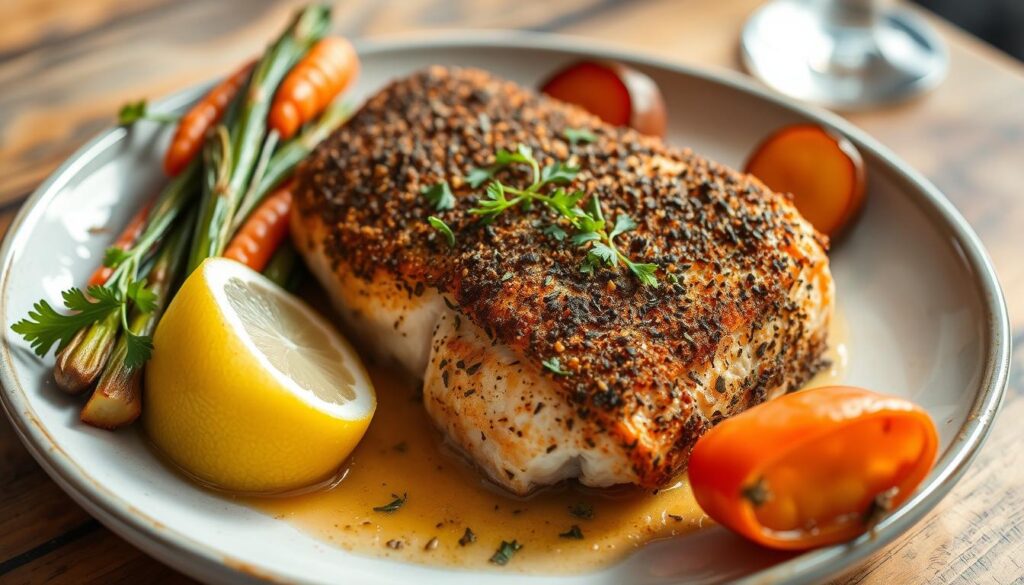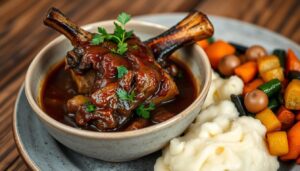Did you know salmon has more potassium than bananas? This fish is not only tasty but also packed with health benefits. Crusted salmon recipes mix amazing flavor with great nutrition, making them perfect for dinner.
In just 15 minutes, you can make a baked salmon dish that turns simple fish into a gourmet meal. This recipe combines a crispy outside with tender, flavorful salmon. It will make your taste buds happy and your body healthy.
The pistachio crusted salmon is a nutritional powerhouse. It has 33 grams of protein and omega-3 fatty acids that boost brain health and the immune system. With only 356 calories, it’s a smart choice for a balanced, tasty meal.
Key Takeaways
- Quick 15-minute preparation time for a gourmet salmon dish
- High protein content with essential omega-3 fatty acids
- Supports brain health and immune system function
- Low-calorie meal option with significant nutritional benefits
- Versatile recipe that can be customized with different nut crusts
Understanding the Nutritional Benefits of Salmon
Salmon is a nutritional powerhouse among seafood entrées. It offers many health benefits, making it a great choice for those who care about their health. This fish has a nutritional profile that supports overall wellness and provides essential nutrients for optimal body function.
Essential Omega-3 Fatty Acids
Salmon’s health benefits start with its omega-3 fatty acids. A 6-ounce serving has about 1.8 grams of these important nutrients. The American Heart Association says omega-3 fatty acids are key for a heart-healthy diet, showing their importance for heart health.
- Supports brain function
- Reduces inflammation
- Promotes heart health
- Helps balance cholesterol levels
Key Vitamins and Minerals
This nutrient-dense fish is full of essential vitamins and minerals that boost overall health. A single serving gives you a lot of these important nutrients:
| Nutrient | Amount per 6-oz Serving | Health Benefit |
|---|---|---|
| Protein | 34 grams | Muscle maintenance |
| Vitamin D | High | Bone health |
| Vitamin B12 | Significant | Energy production |
| Selenium | Rich source | Antioxidant protection |
Anti-inflammatory Properties
Salmon’s unique nutritional makeup helps fight inflammation. Its omega-3 fatty acids and antioxidants like astaxanthin can lower chronic disease risks and boost immune function.
Experts recommend eating salmon at least twice a week to get the most health benefits.
Essential Kitchen Tools and Ingredients
Making a tasty crispy salmon needs the right kitchen tools and ingredients. These can turn a simple meal into a gourmet dish. The right tools and ingredients are key to a great dish.
To make the perfect crusted salmon, you need special tools and top-notch ingredients. Here are the must-haves for your kitchen:
Essential Kitchen Tools
- Large baking sheet or broiler-safe casserole dish
- Digital meat thermometer
- Sharp chef’s knife
- Cutting board
- Mixing bowls
- Measuring cups and spoons
Key Salmon Crust Ingredients
| Ingredient Category | Recommended Options |
|---|---|
| Base Crust | Breadcrumbs, chopped nuts (pistachios), Parmesan cheese |
| Binding Agents | Dijon mustard, honey, olive oil, egg wash |
| Seasonings | Sea salt, black pepper, paprika, garlic powder |
Pro tip: Always choose fresh, high-quality ingredients for the best flavor and texture.
“The secret to a perfect salmon crust lies in the quality of ingredients and precision of preparation.” – Professional Chef Michael Reynolds
When picking kitchen essentials for salmon, look for versatility and quality. A digital thermometer is crucial. It ensures your salmon is cooked to 145°F, for safety and perfect taste.
Selecting the Perfect Salmon Fillet
Choosing the right salmon fillet is key to a tasty and healthy meal. It’s important to know the different types of salmon and their special qualities.
There are two main types of salmon: wild-caught and farm-raised. Each has its own unique taste and texture that can change your cooking and the taste of your dish.
Wild-Caught vs. Farm-Raised Salmon
Wild-caught salmon has a richer flavor and is leaner. Pacific salmon is known for:
- Darker meat coloration
- Denser texture
- Stronger oceanic flavor
Farm-raised salmon, like Atlantic salmon, has different traits:
- Paler meat color
- Higher fat content
- Larger, more consistent flakes
Fresh vs. Frozen Options
Fresh and frozen salmon both have their benefits. It has better texture and lets you control portions. Frozen salmon is a great choice when fresh is hard to find.
Quality Indicators to Look For
Look for these signs of quality from experts:
- Firm, springy flesh
- Bright, consistent color
- Fresh, ocean-like smell
- BAP (Best Aquaculture Practices) certification for farm-raised salmon
“The quality of your salmon determines the success of your entire dish.” – Culinary Expert
Experts say to buy 6-ounce salmon fillets for the best results. Focus on quality and freshness to make a delicious meal.
Creating the Perfect Crusted Salmon
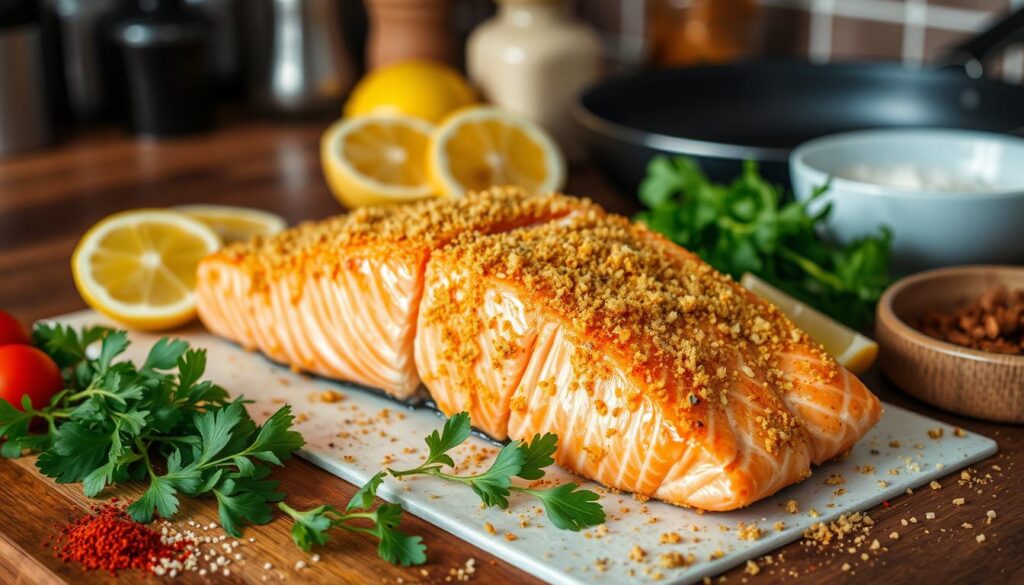
Turning a simple salmon fillet into a crispy masterpiece needs precision and creativity. The secret to making crusty salmon fillets is choosing the right ingredients and mastering a few key techniques.
Start by preparing your salmon with these essential steps:
- Pat the salmon fillet completely dry using paper towels
- Ensure the surface is moisture-free for maximum crispiness
- Select high-quality, fresh salmon for best results
Let’s explore three delectable crust options that will elevate your crispy salmon:
- Classic Spice Crust
- Paprika
- Garlic powder
- Onion powder
- Ground coriander
- Pistachio Maple Crust
- Finely chopped pistachios
- Maple syrup
- Dijon mustard
- Fresh lemon juice
- Minced garlic
- Parmesan Herb Crust
- Plain breadcrumbs
- Grated Parmesan cheese
- Melted butter
- Fresh herbs
“The key to perfect crusty salmon fillets is creating a flavorful, textured coating that locks in moisture while delivering a satisfying crunch.”
When applying your chosen crust, gently press the mixture onto the salmon. This ensures even coverage. It helps the crust stick well and gives a delightful crispy exterior that will wow food lovers.
Pro tip: Use fresh, high-quality ingredients for the most vibrant flavors in your crispy salmon dish.
Mastering the Cooking Temperature and Time
Cooking salmon to perfection needs precision and knowing about temperature. Getting the salmon cooking temperature right can turn an ordinary fish into a culinary masterpiece.
Baking salmon requires careful temperature control for the best flavor and texture. The FDA says to cook salmon to 145°F for it to be fully cooked. But, many chefs like a more delicate approach.
Oven Temperature Guidelines
- Standard baking temperature: 400°F (204°C)
- Roasting temperature for delicate texture: 275°F (135°C)
- Broiling for crispy top: High setting for 1-2 minutes
Internal Temperature Recommendations
Different levels of doneness need specific internal temperatures:
- Medium-rare: 125-130°F (52-54°C)
- Fully cooked: 145°F (63°C)
Timing Tips for Different Fillet Sizes
Cooking time changes with the thickness of your salmon fillet:
| Fillet Thickness | Baking Time | Broiling Time |
|---|---|---|
| 1-inch thick | 12-13 minutes | 8-10 minutes |
| 1.5-inch thick | 13-15 minutes | 10-12 minutes |
“The key to perfect baking salmon is patience and a reliable meat thermometer.” – Professional Chef
Pro tip for baking salmon: Always let the fish rest for a few minutes after cooking. This lets juices redistribute, making it moist and flavorful.
Seasoning Secrets for Maximum Flavor
Making the perfect salmon seasoning turns a simple fish into a dish to remember. Professional chefs say the right spices can make any salmon dish stand out. Our seasoning mix has eight key spices that enhance your salmon’s flavor.
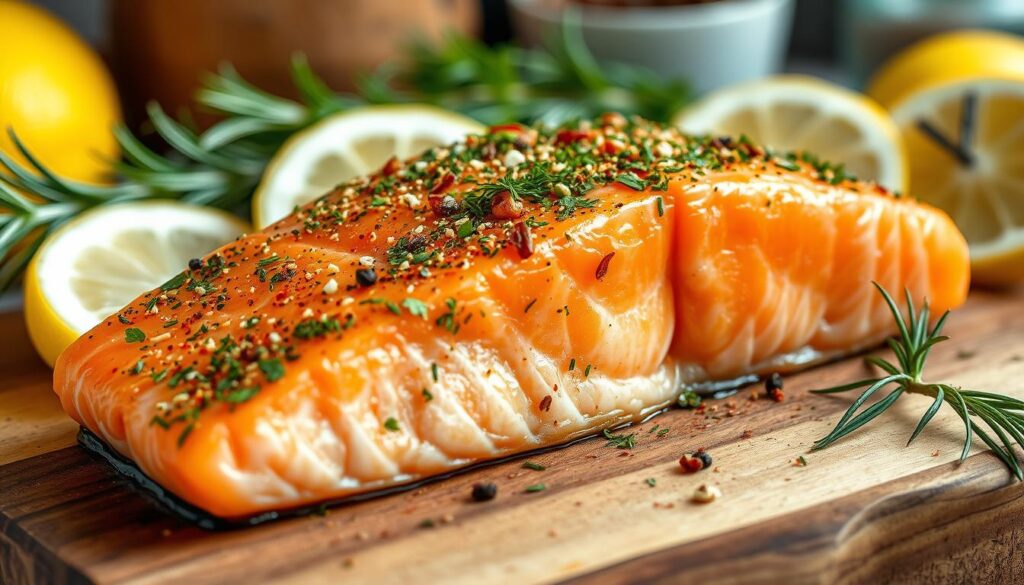
Here are the top secrets for seasoning salmon that will wow your taste buds:
- Key Ingredients for Salmon Seasoning:
- Smoked paprika
- Garlic powder
- Onion powder
- Dried oregano
- Salt
- Black pepper
- Dried thyme
- Cayenne pepper
If you’re on a Low-FODMAP diet, you can still enjoy great flavor. Pro tip: Use dried herbs like oregano and thyme for amazing taste without upsetting your stomach.
“The secret to amazing salmon is not just in the cooking, but in the seasoning” – Culinary Experts
Here are some fun facts to make your seasoning even better:
| Seasoning Detail | Measurement |
|---|---|
| Serving Size | 2 teaspoons |
| Calories per Serving | 8 calories |
| Sodium Content | 281mg |
| Preparation Time | 5 minutes |
Want to elevate your salmon seasoning? Try a nutty pistachio or savory Parmesan crust. Adding lemon juice just before serving can also enhance the flavor, making your salmon dish unforgettable.
Achieving the Perfect Crispy Texture
Getting crispy salmon skin right takes skill and the right cooking techniques. The right steps can turn a simple fish dish into a gourmet meal with a crunchy texture.
Pan-Searing for Ultimate Crispiness
Pan-searing is a top method for crispy salmon skin. Begin by picking a heavy-bottomed skillet and drying the salmon fillets well. Here are the essential steps:
- Heat oil until it shimmers
- Place salmon skin-side down
- Apply gentle pressure with a spatula
- Cook for 3-4 minutes without moving
Broiling Techniques for Crisp Perfection
Broiling is another way to get that crispy salmon skin. Place the oven rack about 6 inches from the heat for the best results.
| Cooking Method | Skin Crispiness | Cooking Time |
|---|---|---|
| Pan-Searing | Very High | 4-5 minutes |
| Broiling | High | 8-12 minutes |
“The secret to crispy salmon skin is moisture removal and high heat” – Professional Chef
Pro tip for cooking salmon: Make sure your salmon is completely dry before cooking. Use paper towels to remove extra moisture. This helps prevent steaming and ensures crispy skin.
Also, remember to cook the salmon to 145°F for the perfect inside while keeping the outside crispy.
Recommended Side Dishes and Pairings
Creating the perfect salmon dinner means choosing the right side dishes. These dishes should match the flavors of your crispy crusted salmon. The right pairings can make your meal unforgettable, balancing flavors and textures.
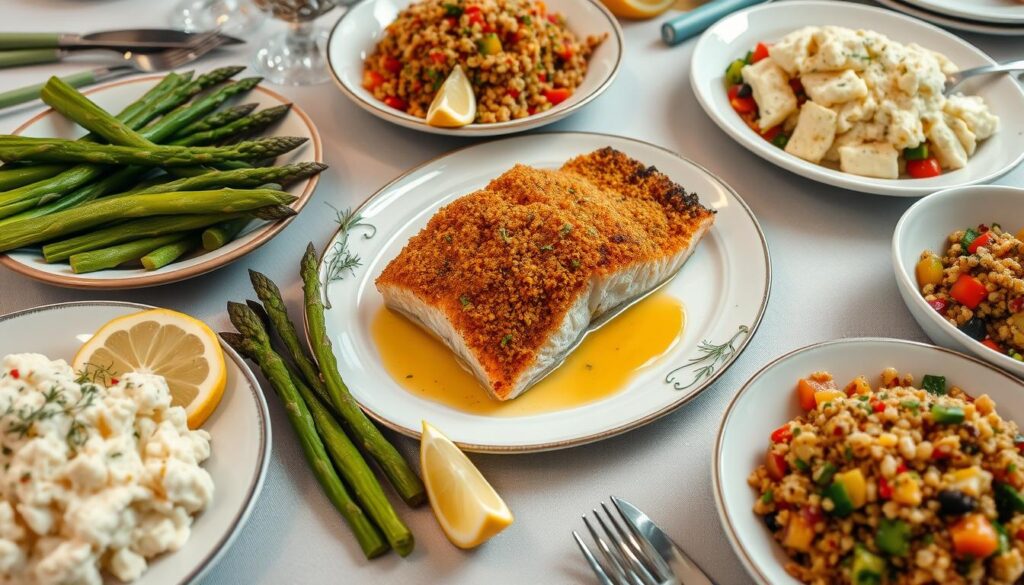
Looking for great side dishes for your salmon? Here are some options that add texture and taste:
- Roasted Vegetable Medley: Brussels sprouts, broccoli, and sweet potatoes roasted to perfection
- Creamy Parmesan Orzo with fresh herbs
- Garlic-Infused Asparagus
- Zesty Kale Salad with apple and honey dressing
“The secret to an exceptional salmon meal lies in choosing side dishes that complement without overwhelming the delicate fish flavor.”
Want to plan the perfect salmon dinner? Here’s a guide to help you choose the best side dishes:
| Side Dish Category | Recommended Options | Preparation Time |
|---|---|---|
| Vegetable Sides | Roasted Broccoli, Grilled Asparagus, Sautéed Sugar Snap Peas | 15-25 minutes |
| Grain Dishes | Cilantro Lime Rice, Whole Wheat Couscous, Arborio Rice | 20-35 minutes |
| Potato Options | Roasted Red Potatoes, Mashed Sweet Potatoes | 30-45 minutes |
Tip for choosing side dishes: Pick light, fresh options that highlight the salmon’s taste. Use citrus, herbs, and simple cooking to make your meals stand out.
Storage and Reheating Tips
Keeping your cooked salmon fresh and tasty is key. You need to store and reheat it right. This ensures it stays good and safe to eat.
- Refrigerate within 2 hours of cooking
- Use an airtight container to prevent moisture loss
- Store in the coldest part of your refrigerator
- Consume within 1-2 days for optimal taste and safety
Reheating Salmon Like a Pro
Reheating salmon can be tricky. But, there are ways to keep it tender and crispy. Here are the best methods:
- Oven Method: Preheat to 275°F-300°F
- Place salmon on a baking sheet
- Warm for 10-15 minutes
- Drizzle with olive oil to retain moisture
- Air Fryer Technique:
- Set temperature to 375°F
- Reheat for 5-7 minutes
- Ensures crispy exterior
- Skillet Reheating:
- Use medium heat
- Add a touch of butter or oil
- Warm skin-side down for 2-3 minutes
Pro Tip: Always use a food thermometer to ensure the salmon reaches an internal temperature of 145°F for safe consumption.
Try not to microwave it, as it can dry out the fish. Each method needs careful attention to avoid overcooking. This keeps the salmon’s flavor and texture just right.
Common Cooking Mistakes to Avoid
Learning how to cook salmon well means knowing the common mistakes. These mistakes can turn a great meal into a bad one. It’s all about paying attention to the details when cooking this delicate fish.
Salmon cooking needs precision and careful attention. Here are some mistakes that can ruin your dish:
- Overcooking: The main reason for dry, tough salmon
- Not using a meat thermometer
- Choosing the wrong oven shelf
- Removing fish too soon from the pan
Professional chefs have some tips to avoid these mistakes:
- Let salmon come to room temperature before cooking
- Dry the fillet well for a crispy crust
- Use just a little oil for a crunchy outside
Kitchen safety is key when cooking salmon. The USDA says rinsing raw salmon can spread bacteria far. This increases the chance of cross-contamination.
“Precision is the secret to perfect salmon” – Professional Chef Recommendation
| Mistake | Consequence | Prevention Tip |
|---|---|---|
| Overcooking | Dry, tough texture | Use meat thermometer |
| Too Much Oil | Soggy crust | Use minimal oil |
| Incorrect Temperature | Uneven cooking | Let salmon reach room temperature |
By knowing these tips and avoiding common mistakes, home cooks can improve their skills. They can make meals as good as those in restaurants with confidence.
Conclusion
Making the perfect crispy crusted salmon turns a simple meal into a special treat. Healthy salmon recipes are not just tasty; they’re also full of nutrients. They have omega-3 fatty acids, protein, and vitamins. This dish has won the hearts of many, with millions of views and great reviews.
Salmon is very versatile, allowing for endless creativity in the kitchen. You can try lemon and dill, garlic butter, or pesto. By learning simple techniques and using top-quality fillets, you can make gourmet salmon meals at home.
This dish is a perfect mix of nutrition and flavor. One serving has 34 grams of protein, 1,500 milligrams of omega-3s, and 80% of vitamin D. By trying different crusts and cooking methods, you can make a memorable meal that’s good for you.
Start enjoying cooking and explore the world of delicious, healthy salmon dishes. Your cooking adventure begins with learning techniques, trying new flavors, and celebrating the amazing qualities of this fish.
